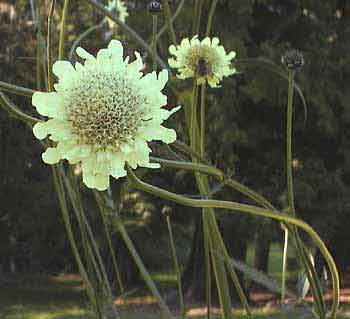Cephalaria gigantea
GIANT SCABIOSA,YELLOW SCABIOSA,TATARIAN CEPHALARIA
Family: Dipsacaceae
Pronounced: seff-al-AY-ri-a gi-GAN-tee-a
Quick Jumps
Growing Guide
Rainy Side Notes
GROWING GUIDE

Origin:
Caucasus and Siberia.
Plant Group:
Perennial.
Hardiness:
Sunset zones: 2-10, 14-24.
USDA zones: 4-9.
Mature size:
Height: 6 feet (2 m).
Width: 4 feet (1.5 m).
Flowering period:
June through August.
Flowering attributes:
Yellow, scabiosa-like flowers.
Leaf attributes:
Oblong, broadly lanceolate and coarsely toothed leaves.
Growth habit:
Clump forming.
Light:
Full sun.
Soil:
Moderately fertile, moisture retentive soils, including our NW clay soil.
Propagation Methods:
Sow at 70ºF; if no germination in 3-4 weeks, move to fridge for 2-4 weeks; or sow seed and place in cold frame in early spring. | Divide in spring.
Pruning:
Deadhead to keep flowers going. When plant is done flowering, cut back and trim foliage as necessary for a tidier appearance.
Rainy Side Notes
Cephale is Greek for the word head. Member of the teasel family and closely related to Scabiosa, it was one time in the same genus. This tall perennial needs room for growth. It is a coarse plant, so grow it at the back of the border.
With the flower’s striking yellow color and long stems, it makes a worthy cut flower, as well as a good forage plant for bees.
Photographed in author's garden.

Gardening for the Homebrewer: Grow and Process Plants for Making Beer, Wine, Gruit, Cider, Perry, and More
By co-authors Debbie Teashon (Rainy Side Gardeners) and Wendy Tweton
Copyright Notice | Home | Search | Perennials

